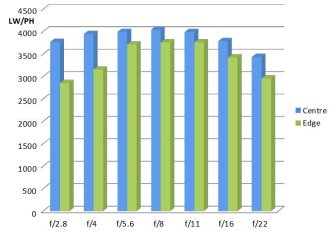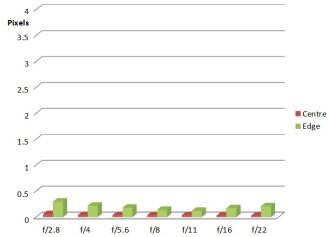Zeiss Milvus 15mm f/2.8 Review
Zeiss Milvus 15mm f/2.8 Performance
Central sharpness is very impressive, already being excellent at the open aperture of f/2.8 and then approaching an outstanding performance by f/4. f/5.6 to f/11 give outstanding results and sharpness is still excellent at f/16 and f/22.
The edges are not far behind, being very good at f/2.8 and f/4. Sharpness is then excellent from f/5.6 through to f/16 and even at f/22 is very good.
How to read our charts
The blue column represents readings from the centre of the picture frame at the various apertures and the green is from the edges.The scale on the left side is an indication of actual image resolution as LW/PH and is described in detail above. The taller the column, the better the lens performance.
For this review, the lens was tested on a Nikon D810 using Imatest.
CA (Chromatic Aberration) is very low, both at centre and edge of the image field. It is hard to imagine that most shots would need any further work on this, but if desired the whisker of fringing left could easily be tackled in software.
How to read our charts
Chromatic aberration is the lens' inability to focus on the sensor or film all colours of visible light at the same point. Severe chromatic aberration gives a noticeable fringing or a halo effect around sharp edges within the picture. It can be cured in software.Apochromatic lenses have special lens elements (aspheric, extra-low dispersion etc) to minimise the problem, hence they usually cost more.
For this review, the lens was tested on a Nikon D810 using Imatest.
The lens exhibits -2.14% of barrel distortion, which is not unexpected. This can be corrected in software, but it can also look perfectly fine in many ultra-wide images.
Flare resistance is excellent, with not a trace of contrast loss or artefacts even when the low sun is right on the edge of the frame.
Bokeh is usually far more obvious in telephoto lenses, so there is no really dramatic effect here. However, with very close subjects it is possible to have some differential focus and the bokeh, the effect on the out of focus background, in these circumstances, seems smooth and pleasant enough.
This is an excellent standard and the Milvus shows itself to be a lens of very high performance.
Value For Money
The Zeiss Milvus 15mm f/2.8 is priced at £1999 and the obvious comparison is with the recently reviewed Irix 15mm f/2.4 Blackstone, which is also a manual focus lens and priced at £568. There is also the plastic bodied Firefly version of the Irix lens at £428.
This compares with the Samyang 14mm f/2.8 ED AS IF UMC at £299.
Canon users have the EF 14mm f/2.8L II USM (£1849) and Nikon users have the Nikon 14mm f/2.8D AF ED (£1389).
These are tough figures to equate with need, and although the Zeiss lens is the most expensive, it does offer a very high level of performance. The marque lenses also offer AF, but buyers of the Zeiss may well have their own thoughts about that Zeiss quality.
Weighing up the overall balance between price and the other factors involved in choice, the Zeiss Milvus 15mm f/2.8 lens is good value for money for what it delivers, but good results can still be found at much lower price levels. This will not deter those who want the Zeiss lens from paying the higher price.
For more options have a look at the Top 15 Wide-angle Landscape Lenses.
Add your message
Please login here or if you've not registered, you can register here. Registering is safe, quick and free.
photodo Stats
428 MTF tests
74 in-depth photodo reviews
100+ users join each day
Help the lens community by reviewing or rating a lens today via our lens search
Latest Lens Reviews
- Chinon 28mm f/2.8 Vintage Lens Review
- Canon EF 70-200mm f/4L IS II USM Lens Review
- Samyang AF 85mm f/1.4 EF Review
- Sigma 70mm f/2.8 DG Macro Art Review
- Samyang AF 24mm f/2.8 FE Review
- Meike 50mm f/1.7 Review
- Tamron 70-210mm f/4 Di VC USD Review
- Lensbaby Burnside 35mm f/2.8 Review
- Asahi Super Takumar 50mm f/1.4 Review
- Asahi Super-Multi-Coated Takumar 135mm f/3.5 Review


